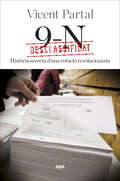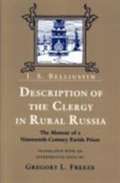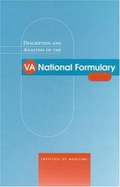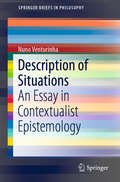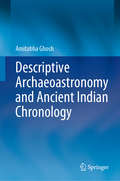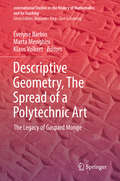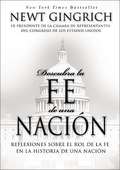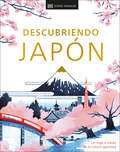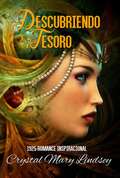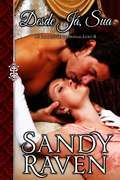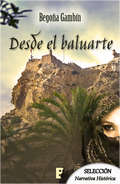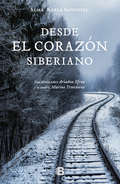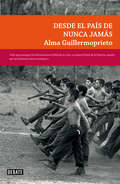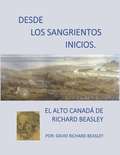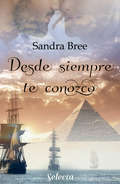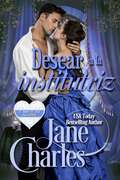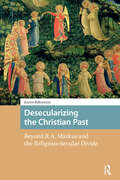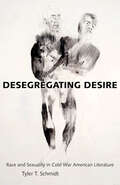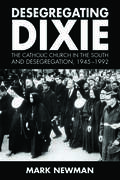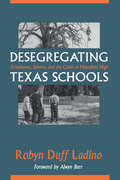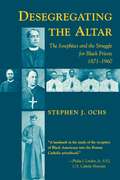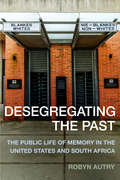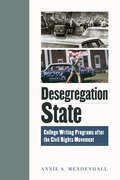- Table View
- List View
Desclassificat: Història secreta d’una votació revolucionària
by Vicent PartalUn testimoni excepcional i únic d'un episodi revolucionari de la nostra història. Converses privades, negociacions in extremis, cops i contracops, amistats perilloses i fins i tot corredisses pels passadissos del Palau de la Generalitat. Els esdeveniments que van culminar en la consulta del 9 de novembre de 2014 són dignes d'inspirar una història d'intriga, i és justament per això que l'autor recorre a l'estructura d'una sèrie televisiva per narrar -amb els detalls més llaminers i sorprenents però sense apartar-se mai del rigor i l'anàlisi periodística- uns fets que van convertir Catalunya en centre d'interès mundial. Vicent Partal Director del principal diari electrònic del país, ens brinda l’oportunitat de mirar i escoltar de ben a prop tot allò que només van poder veure i sentir els negociadors més directes de la consulta sobre la independència.
Description Of The Clergy In Rural Russia: The Memoir Of A Nineteenth-Century Parish Priest
by Gregory L. Freeze I. S. BelliustinReligious life has been perhaps the least explored and most poorly understood aspect of imperial Russian history. This annotated translation of a dissident priest's exposé of the parish clergy adds significantly to our knowledge, providing a graphic picture of the Orthodox church in the mid-nineteenth century. For the first time, we are able to grasp the profound importance of the church in the everyday lives of ordinary men and women.I. S. Belliustin's Description of the Clergy in Rural Russia was published abroad and smuggled back into the empire in 1858, on the eve of the Great Reforms. Its shocking depiction of a church pervaded by venality and ignorance created a sensation in high society and government circles. It generated a new sense of self-awareness among the younger clergy and sparked a reform movement that climaxed in the years just before the 1917 Revolution. Much more than a chapter in the history of Russian Orthodoxy, Belliustin's memoir is a major document in Russian social history. Throughout, the author ranges beyond the seminary and the parish to touch on almost every aspect of village life. Gregory Freeze has translated this text and supplied extensive annotations. His introduction is a masterly—and long-needed—survey of the church's role in the social and political life of imperial Russia.Written by a wry and trenchant observer, this portrait of rural Russia will be read with interest by students and scholars of Russian history, of the Orthodox church, and of the social and religious history of nineteenth-century Europe.
Description and Analysis of the VA National Formulary
by Institute of MedicineThe National Academies Press (NAP)--publisher for the National Academies--publishes more than 200 books a year offering the most authoritative views, definitive information, and groundbreaking recommendations on a wide range of topics in science, engineering, and health. Our books are unique in that they are authored by the nation's leading experts in every scientific field.
Description of Situations: An Essay in Contextualist Epistemology (SpringerBriefs in Philosophy)
by Nuno VenturinhaThis book approaches classic epistemological problems from a contextualist perspective. The author takes as his point of departure the fact that we are situated beings, more specifically that every single moment in our lives is already given within the framework of a specific context in the midst of which we understand ourselves and what surrounds us.In the process of his investigation, the author explores, in a fresh way, the works of key thinkers in epistemology. These include Bernard Bolzano, René Descartes, Gottlob Frege, Edmund Husserl, Immanuel Kant and Ludwig Wittgenstein, but also contemporary authors such as Stewart Cohen, Keith DeRose, David Lewis, Duncan Pritchard, Ernest Sosa and Charles Travis. Some of the topics covered are attributions of knowledge, the correspondence theory of truth, objectivity and subjectivity, possible worlds, primary and secondary evidence, scepticism, transcendentalism and relativism. The book also introduces a new contextualist thought-experiment for dealing with moral questions.Contextualism has received a great deal of attention in contemporary epistemology. It has the potential to resolve a number of issues that traditional epistemological approaches cannot address. In particular, a contextualist view opens the way to an understanding of those cognitive processes that require situational information to be fully grasped. However, contextualism poses serious difficulties in regard to epistemic invariance. This book offers readers an innovative approach to some fundamental questions in this field.
Descriptive Archaeoastronomy and Ancient Indian Chronology
by Amitabha GhoshThis book presents the basic fundamentals of descriptive archaeoastronomy and its application to the astronomical descriptions found in ancient Indian scriptures. Archaeoastronomy is a branch of positional astronomy that helps to determine the epochs of ancient astronomical alignments and special astronomical events. In this book, only the descriptions of special stellar alignments and events found in ancient texts can identify the antiquity of the descriptions. India possesses a large volume of ancient scriptures like Vedas and Puranas which contain many astronomical descriptions as in ancient India positional astronomy was well developed. The antiquities of these texts are determined through archaeoastronomical techniques. Major events like Mahabharata War are dated and using these dates a chronology of ancient India is determined. The astronomically determined chronology is compared with the results from various archaeological, palaeoclimatological, geological and genealogical investigations of ancient India. This introductory book interests readers interested in unveiling the mystery involved with the protohistory of this ancient civilization.
Descriptive Geometry, The Spread of a Polytechnic Art: The Legacy of Gaspard Monge (International Studies in the History of Mathematics and its Teaching)
by Klaus Volkert Évelyne Barbin Marta MenghiniThis book seeks to explore the history of descriptive geometry in relation to its circulation in the 19th century, which had been favoured by the transfers of the model of the École Polytechnique to other countries. The book also covers the diffusion of its teaching from higher instruction to technical and secondary teaching. In relation to that, there is analysis of the role of the institution – similar but definitely not identical in the different countries – in the field under consideration. The book contains chapters focused on different countries, areas, and institutions, written by specialists of the history of the field. Insights on descriptive geometry are provided in the context of the mathematical aspect, the aspect of teaching in particular to non-mathematicians, and the institutions themselves.
Descubra la fe de una nación
by Newt GingrichUn paseo simple por Washington, D.C. fue el inicio de un recorrido profundo de descubrimiento personal y de renovación para Newt Gingrich, uno de los políticos y comentadores más influyentes de Estados Unidos. Un día mientras leía los archivos nacionales, las palabras inmortales de la Declaración de Independencia: "Nuestro Creador nos ha dotado de ciertos derechos inalienables", saltaron de la página y penetraron en su corazón presentándole la clara verdad de que desde el inicio de la historia de ese país, el autor de la libertad no era el estado o los Padres de la patria. Nuestros derechos y libertades básicas humanas eran y todavía son "dadas por el Creador". Gingrich suena la alarma para que reconozcamos que la vida, la libertad y la búsqueda de la felicidad que valoramos tanto son conceptos inseparables de un sincero y humilde reconocimiento de que estos regalos son sólo dados por el Creador. El libro también incluye como material extra un "recorrido a pie" de Washington, D.C.
Descubriendo Japón (Be More Japan): Un viaje a través de la cultura japonesa
by DK EyewitnessExplora la tierra de sol naciente y descubre por qué la cultura japonesa es únicaDéjate seducir por la belleza efímera de los cerezos en flor, acude a un animado festival veraniego, saboreala meticulosidad de la ceremonia del té, canta tu canción favorita a pleno pulmón en un karaoke o disfruta de una terma natural con espectaculares vistas al monte Fuji.Tanto si buscas planificar tu primer viaje al país nipón como si simplemente deseas aprender más sobre Japón y su cultura, esta completa guía de viaje tiene todo lo necesario para descubrir este fascinante país del este asiático:-Información sobre la geografía, la historia, la religión y el legado cultural de Japón en el mundo.-Asombrosas fotografías y descripciones de las atracciones más interesantes del país, desde templos, castillos y festivales hasta vibrantes núcleos urbanos y paisajes rurales y naturales únicos.-Un recorrido culinario por los sabores y platos de la gastronomía japonesa. -Datos y curiosidades sobre el arte, la moda, la música, el bienestar y el desarrollo tecnológico e innovación del país.-Interesantes secciones sobre los valores de la sociedad japonesa, sus rituales y protocolos, los mitos y leyendas de su cultura, sus ritos y tradiciones ancestrales, así como costumbres habituales en la vida diaria.Descubre los encantos y rincones mágicos de Japón en cada página, viaja desde tu sofá y sorpréndete con un país de contrastes donde la tradición y modernidad conviven en perfecta armonía. —-----------------------------------------------------------------Be More Japan is a celebration of all things Japanese. You can take a look through popular sights and pick and choose what interests you to plan your perfect trip. Or take a trip through everything to get the full experience of Japan. Whether you use Be more Japan as a travel guide or to help you learn more about the Japanese culture. Be More Japan helps you understand and experience the best of Japan, both at home and abroad. For those who can’t make the trip to Japan, or who want to carry on the experience when they return, this book also has useful tips and suggestions for how to bring Japanese culture to you, and places where you can see its influence around the world.With this book you can: -Learn about the traditional skills of the tea ceremony and calligraphy-Dive into the captivating culture of Japan, with topics such as art, music, food, wellness and innovation-Find details on topics such as transport, karaoke, ikigai, shopping and hot springs to help you make the most of your trip to JapanRevised and updated, and with each page alive with facts, history, and inspiration, Be More Japan unlocks the secrets behind modern Japanese living - whether you're eating sushi in London or enjoying the cherry blossoms in San Francisco. And if you're dreaming of a future trip to Japan, this book will get you closer to your destination before you've even departed.
Descubriendo a Tesoro
by Crystal Mary Lindsey Erika CarballoEs 1925 y París es la ciudad del romance y la moda exótica. Tesoro Gilroy es una modelo famosa que vive en el corazón de este deslumbramiento y trabaja entre Londres, Nueva York y Milán. Entonces, repentina e inexplicablemente, se desvanece de su opulento estilo de vida. Tras haber heredado los bienes de su abuela, Tesoro viaja de regreso a un hermoso valle al otro lado de las Montañas Azules, en el interior de Australia. Viaja con su mejor amiga, Bella, que es inglesa y trabaja como peluquera francesa. Han sido amigas durante algunos años, pero hay algo misterioso en Bella y ninguna de las dos puede explicar su vínculo misterioso. Cuando Tesoro se encuentra con el abogado de su abuela, Connor Latham, quien es un piloto de combate de la Primera Guerra Mundial que regresó, las pasiones se encienden; sin embargo, Connor alterna entre chisporroteo y hielo cuando están juntos. ¿Treasure perderá su corazón hacia él? Se descubren los secretos de la familia y se revelan los esqueletos en el armario. Finalmente Tesoro gana comprensión de las muchas incertidumbres que enfrenta. A medida que forja nuevos comienzos, la tristeza en su corazón comienza a disiparse. ¿Dónde encaja la creencia en Dios? Tesoro ha sido criada sin ningún conocimiento de Jesús, por lo que no ve necesidad de él. ¿Llegará a un entendimiento sobre el amor incondicional de Dios hacia ella? ¿Ella recibe el obsequio ofrecido, o lo rechaza? Este romance cristiano despierta la magia en la mente y la música en el alma.
Desde Já, Sua - As Crônicas de Caversham, Livro II
by Sandy RavenEla o amou durante toda a sua vida. Lady Elise Halden sabe como fazer um cavalo se dobrar à sua vontade, com um toque suave e persuasão sutil. Mas está aprendendo que fazer o novo conde de Camden se render é bem diferente de treinar um cavalo. Se ela quiser ter alguma esperança de controlar as afeições do conde, precisará elaborar um plano. Com a ajuda de sua amiga lady Beverly e sua cunhada, a duquesa, Elise se dispõe a conquistar o coração de seu indiferente conde. Ele a admirou a uma distância respeitável. Quando jovens, Michael Brightman e seu melhor amigo juraram que suas irmãs estavam fora de cogitação nas suas conquistas. Uma promessa feita apenas para proteger sua própria irmã do modo encantador e libertino de seu amigo. A irmã mais nova do duque de Caversham sempre foi uma sirigaita precoce a ser evitada, até que um dia Michael percebe que lady Elise cresceu e que aquilo que ele deseja fazer com a jovem certamente irá perturbar a sua amizade com o irmão dela. Juntos, eles descobrem que a evidência física não revela a verdade, e que confiar no coração às vezes é a lição mais difícil de se aprender.
Desde el baluarte
by Begoña GambínUna novela de acción, amor y suspense que nos transporta al Califato de Abderramán III, un mundo fascinante de mezquitas y alcazabas lleno de intrigas. Una novela que cabalga entre dos épocas e historias distintas entrelazando pasajes verídicos de la historia del siglo X y la leyenda del origen del nombre de Alicante, con otros de ficción que transcurren en el siglo XXI. En la época actual, unos descubrimientos arqueológicos en Alicante permiten la investigación de unos sucesos que, presumiblemente, transcurrieron durante el Califato de Abderramán III y que podrían desestabilizar el mundo musulmán actual. Una joven pareja, Raquel, empresaria y Eduardo, arqueólogo, acompañados por Juan Pablo, experto en estudios islámicos, se ven envueltos en una serie de aventuras que los llevan desde la monumental Córdoba hasta la exótica Damasco al pretender desentrañar el misterio mientras son perseguidos por un grupo terrorista islámico. Por otro lado, en los capítulos con base histórica de la época del Califato de Abderramán III, se parte de una leyenda para narrar la historia de amor imposible entre una pareja árabe, Cántara y Alí, a la vez que se va desvelando la trama de los sucesos investigados en la época contemporánea.
Desde el corazón siberiano
by Alma Karla SandovalUna novela sobre Ariadna Efron y su madre, Marina Tsvetáieva. Unión Soviética, 1947. En el inclemente corazón de Siberia, dentro de uno de los cientos de campos de trabajo forzado que el régimen estalinista ha instalado por todo el país, Ariadna Efron padece lo que ella cree que será el último año de una condena absurda. Su crimen, ser hija de Serguéi Efron -supuesto doble agente de la policía secreta que, dicen, participó en un atentado político-, y de la gran poeta Marina Tsvetáieva -quien ha elegido para sí el sublime destino de ser un espíritu libre, motivo suficiente para que el Estado la censure-. Sin embargo, Ariadna no sospecha que aún le queda un largo camino por recorrer en el sistema de reeducación del Estado soviético, tampoco que tendrá que asumir la tarea de reivindicar la obra de su madre, y menos que el amor la salvará de un destino gris. Basada en hechos reales y otros ficcionalizados, Desde el corazón siberiano entrelaza la historia de Ariadna Efron y su madre, Marina Tsvetáieva, una de las más grandes poetas que ha dado Rusia; pero es también la historia de una época signada por la desgracia, la traición, la locura y la sinrazón, donde sólo el amor, en todas sus formas, será capaz de transformar su sino.
Desde el país de nunca jamás
by Alma GuillermoprietoUna magnífica selección de reportajes de Alma Guillermoprieto. Premio Princesa de Asturias de Comunicación y Humanidades 2018 El conflicto civil en El Salvador, la crisis de Granada, la masacre del Mozote, el éxito internacional del grupo adolescente latinoamericano Menudo, la proliferación de sectas y religiones en Río de Janeiro o la lucha entre el gobierno peruano y Sendero Luminoso son solo algunos de los temas que trata Alma Guillermoprieto en sus legendarias crónicas. Publicadas entre 1980 y 2008 en The Washington Post, The New Yorker y The New York Review of Books son pequeñas obras de arte que revelan la cara más humana de algunos de los grandes acontecimientos de los últimos treinta años en América Latina. Reseñas:«Magistral. América Latina ya tiene su Orwell.»David Remnick «Alma Guillermoprieto seenfrenta a la vida con un cuaderno y un bolígrafo en la mano. Es su forma de vida. Es su pasión. Y la disfruta con toda la intensidad posible.»Milenio «Su periodismo temerario, al igual que sus espléndidas descripciones y sus retratos de personajes, son fascinantes.»The Wall Street Journal «Una maravillosa lectura, repleta de humanidad, astucia, curiosidad y conocimiento.»The New York Times Book Review «Guillermoprieto hace una descripción íntima y conmovedora, dura e inteligente de la vida cotidiana durante la revolución.»San Francisco Chronicle, sobre La Habana en un espejo
Desde los sangrientos inicios: El Alto Canadá de Richard Beasley
by David Richard BeasleyLA HISTORIA, LA GUERRA AMERICANA, LA GUERRA DE 1812, EL ALTO CANADÁ. Desde 1766, y con tan solo cinco años, Richard Beasley, como testigo, nos narra las rebeliones de los arrendatarios en el estado de Nueva York, las cuales son seguidas por la revolución americana y como las vidas de su padre Henry Beasley y su tío Richard Cartwright son puestas bajo riesgo por las fuerzas lealistas en Albany, Nueva York a lo largo de los horrores de la guerra civil. Richard Beasley, como economato del Fuerte Niagara, observa la guerra desde fuera, presentándonos a su primo Richard Cartwright, quien funge como secretario del mayor John Butler de los Comandos Butler, al jefe Joseph Brant y al alférez Walter Butler mientras el continua con su comercio de pieles en Toronto y en Head of the Lake en Ontario. Después de la guerra nos relata sobre sus transacciones con la tierra, negocios comerciales y su asociación de intercambio comercial con Richard Cartwright y Robert Hamilton; de sus argumentos en nombre de los colonos en la legislatura en donde fue orador de la Asamblea, y su participación como agente en las compañías de tierra alemanas en los condados de Markham y Waterloo, particularmente durante la conspiración de Aaron Burr con los franceses para recuperar Canadá lo que lo convierte en sospechoso ante la oligarquía de York, que pasó a llamarse Toronto. Durante la guerra de 1812, como magistrado y organizador de la milicia en el Oeste de York tuvo varios roles. Nos describe las batallas en la península de Niagara en las que estuvo involucrado como coronel del segundo regimiento de York. Richard se torna más liberal, mientras que su primo, el intelectual Richard Cartwright, se vuelve más conservador y prominente. Su correspondencia con Lord Erskine, Famoso Defensor de las libertades civiles, su labor por la libertad de prensa, su defensa de las reformas de Robert Gourlay y
Desde siempre te conozco
by Sandra BreeUna apasionante aventura que no te dejará indiferente. Marina, estudiante de arqueología, lleva una vida monótona y normal hasta el día en el que halla, en una réplica de la pirámide de Keops, una puerta en el tiempo que la lleva hasta Tortuga en el año 1663. Allí conoce a Jeremy, un pirata apuesto y bribón que está desesperado por escapar de la isla ya que le buscan para ahorcarle. Por los intereses de ambos, Jeremy y Marina se unen para averiguar cuál es el secreto de Keops, y en su periplo, no solo conocerán la leyenda de la historia jamás contada por Henutsen, esposa del gran faraón Jufu, sino que prenderá en ellos una pasión arrolladora, un amor mágico y un extraño vinculo que, de la misma manera que los une, los separa una y otra vez. ¿Serán capaces de reunirse definitivamente en algún lado o seguirán viajando hasta vivir las mil vidas de las que hablan los papiros egipcios? ¿Entre un mundo y otro tan solo hay un suspiro? En los blogs...«Su historia de amor es preciosa, aunque da giros inesperados que te mantienen en vilo y te llevan a devorar y devorar páginas para encontrar una solución a la trama tan elaborada y llena de emociones que ha creado la autora. Es magnífico cómo Sandra Bree ha enlazado presente y pasado, realidad y leyenda, o lugares tan dispares como Madrid, el Caribe y Egipto, y que juntos hagan un todo perfecto y lleno de sentido.»Blog A merced de las musas
Desear a la institutriz (El amor de una institutriz #1)
by Jane CharlesCuando la señorita Althea Claywell se entera de la decisión de su tío de casarla con un amigo suyo de sesenta años, huye. Durante la huida pasa por un pequeño pueblo donde se encuentra con Lord Preston Ambrose, vizconde de Melcombe, que también necesita una institutriz para sus cinco sobrinas. Althea acepta el puesto con pocas reservas. A su tío nunca se le ocurriría buscarla en Ambrose Hall. Preston se sintió atraído por a la señorita Claywell desde el primer momento en que la vio en Londres, pero sólo consiguió comparatir con ella dos bailes antes de tener que regresar a casa. Cuando se topa con la señorita Claywell en el pueblo, le ofrece el único puesto que es probable que ella acepte. Lo que realmente desea es tenerla en su cama. ¿Gobernará el deseo o conseguirán dar paso al amor antes de que alguien encuentre a Althea?
Desecularizing the Christian Past: Beyond R.A. Markus and the Religious-Secular Divide
by Enrico BeltraminiThe essential objective of this study is to unpack the complicity between historians and secularization theory in the study of late ancient and early medieval Christianity—and then suggest a way out. In this work of historiography of religion, Enrico Beltramini argues that religious history is inherently secular and produces distorted representations of the Christian past. He suggests moving from an epistemological to a hermeneutical approach so that the supernatural worldview of the Christian past can be addressed on its own terms. This work also engages Markus’s saeculum and replaces Markus’s secularized relationship between the Kingdom and the government of the civitas with the Augustinian association of the Kingdom and divine government.
Desegregating Desire: Race and Sexuality in Cold War American Literature
by Tyler T. SchmidtA study of race and sexuality and their interdependencies in American literature from 1945 to 1955, Desegregating Desire examines the varied strategies used by eight American poets and novelists to integrate sexuality into their respective depictions of desegregated places and emergent identities in the aftermath of World War II. Focusing on both progressive and conventional forms of cross-race writing and interracial intimacy, the book is organized around four pairs of writers. Chapter one examines reimagined domestic places, and the ambivalent desires that define them, in the southern writing of Elizabeth Bishop and Zora Neale Hurston. The second chapter; focused on poets Gwendolyn Brooks and Edwin Denby, analyzes their representations of the postwar American city, representations which often transpose private desires into a public imaginary. Chapter three explores how insular racial communities in the novels of Ann Petry and William Demby were related to non-normative sexualities emerging in the early Cold War. The final chapter, focused on damaged desires, considers the ways that novelists Jo Sinclair and Carl Offord, relocate the public traumas of desegregation with the private spheres of homes and psyches. Aligning close textual readings with the segregated histories and interracial artistic circles that informed these Cold War writers, this book defines desegregation as both a racial and sexual phenomenon, one both public and private. In analyzing more intimate spaces of desegregation shaped by regional, familial, and psychological upheavals after World War II, Tyler T. Schmidt argues that “queer” desire—understood as same-sex and interracial desire—redirected American writing and helped shape the Cold War era’s integrationist politics.
Desegregating Dixie: The Catholic Church in the South and Desegregation, 1945-1992
by Mark NewmanWinner of the 2020 American Studies Network Book Prize from the European Association for American StudiesMark Newman draws on a vast range of archives and many interviews to uncover for the first time the complex response of African American and white Catholics across the South to desegregation. In the late nineteenth and first half of the twentieth century, the southern Catholic Church contributed to segregation by confining African Americans to the back of white churches and to black-only schools and churches. However, in the twentieth century, papal adoption and dissemination of the doctrine of the Mystical Body of Christ, pressure from some black and white Catholics, and secular change brought by the civil rights movement increasingly led the Church to address racial discrimination both inside and outside its walls. Far from monolithic, white Catholics in the South split between a moderate segregationist majority and minorities of hard-line segregationists and progressive racial egalitarians. While some bishops felt no discomfort with segregation, prelates appointed from the late 1940s onward tended to be more supportive of religious and secular change. Some bishops in the peripheral South began desegregation before or in anticipation of secular change while elsewhere, especially in the Deep South, they often tied changes in the Catholic churches to secular desegregation. African American Catholics were diverse and more active in the civil rights movement than has often been assumed. While some black Catholics challenged racism in the Church, many were conflicted about the manner of Catholic desegregation generally imposed by closing valued black institutions. Tracing its impact through the early 1990s, Newman reveals how desegregation shook congregations but seldom brought about genuine integration.
Desegregating Private Higher Education in the South: Duke, Emory, Rice, Tulane, and Vanderbilt
by Melissa KeanAfter World War II, elite private universities in the South faced growing calls for desegregation. Though, unlike their peer public institutions, no federal court ordered these schools to admit black students and no troops arrived to protect access to the schools, to suggest that desegregation at these universities took place voluntarily would be misleading In Desegregating Private Higher Education in the South,Melissa Kean explores how leaders at five of the region's most prestigious private universities -- Duke, Emory, Rice, Tulane, and Vanderbilt -- sought to strengthen their national position and reputation while simultaneously answering the increasing pressure to end segregation.To join the upper echelon of U. S. universities, these schools required increased federal and northern philanthropic funding. Clearly, to receive this funding, schools had to eliminate segregation, and so a rift appeared within the leadership of the schools. University presidents generally favored making careful accommodations in their racial policies for the sake of academic improvement, but universities' boards of trustees -- the presidents' main opponents -- served as the final decision-makers on university policy. Board members--usually comprised of professional, white, male alumni--reacted strongly to threats against southern white authority and resisted determinedly any outside attempts to impose desegregation.The grassroots civil rights movement created a national crisis of conscience that led many individuals and institutions vital to the universities' survival to insist on desegregation. The schools felt enormous pressure to end discrimination as northern foundations withheld funding, accrediting bodies and professional academic associations denied membership, divinity students and professors chose to study and teach elsewhere, and alumni withheld contributions. The Brown v. Board of Education decision in 1954 gave the desegregation debate a sense of urgency and also inflamed tensions -- which continued to mount into the early 1960s. These tensions and the boards' resistance to change created an atmosphere of crisis that badly eroded their cherished role as southern leaders. When faced with the choice between institutional viability and segregation, Kean explains, they gracelessly relented, refusing to the end to admit they had been pressured by outside forces.Shedding new light on a rare, unexamined facet of the civil rights movement, Desegregating Private Higher Education in the South fills a gap in the history of the academy.
Desegregating Texas Schools: Eisenhower, Shivers, and the Crisis at Mansfield High
by Robyn Duff LadinoIn the famous Brown v. the Board of Education decisions of 1954 and 1955, the United States Supreme Court ruled that "separate but equal" schools for black and white students were unconstitutional. Yet history records that it took more than a decade of legal battles, civil rights protests, and, tragically, violent confrontations before black students gained full access to previously white schools. Mansfield, Texas, a small community southeast of Fort Worth, was the scene of an early school integration attempt. In this book, Robyn Duff Ladino draws on interviews with surviving participants, media reports, and archival research to provide the first full account of the Mansfield school integration crisis of 1956. Ladino explores how power politics at the local, state, and federal levels ultimately prevented the integration of Mansfield High School in 1956. Her research sheds new light on the actions of Governor Allan Shivers—who, in the eyes of the segregationists, actually validated their cause by his political actions—and it underscores President Dwight Eisenhower’s public passivity toward civil rights during his first term of office. Despite the short-term failure, however, the Mansfield school integration crisis helped pave the way for the successful integration of Central High School in Little Rock, Arkansas, in 1957. Thus, it deserves a permanent place in the history of the civil rights movement, which this book amply provides.
Desegregating Texas Schools: Eisenhower, Shivers, and the Crisis at Mansfield High
by Robyn Duff LadinoIn the famous Brown v. the Board of Education decisions of 1954 and 1955, the United States Supreme Court ruled that "separate but equal" schools for black and white students were unconstitutional. Yet history records that it took more than a decade of legal battles, civil rights protests, and, tragically, violent confrontations before black students gained full access to previously white schools. Mansfield, Texas, a small community southeast of Fort Worth, was the scene of an early school integration attempt. In this book, Robyn Duff Ladino draws on interviews with surviving participants, media reports, and archival research to provide the first full account of the Mansfield school integration crisis of 1956. Ladino explores how power politics at the local, state, and federal levels ultimately prevented the integration of Mansfield High School in 1956. Her research sheds new light on the actions of Governor Allan Shivers—who, in the eyes of the segregationists, actually validated their cause by his political actions—and it underscores President Dwight Eisenhower's public passivity toward civil rights during his first term of office. Despite the short-term failure, however, the Mansfield school integration crisis helped pave the way for the successful integration of Central High School in Little Rock, Arkansas, in 1957. Thus, it deserves a permanent place in the history of the civil rights movement, which this book amply provides.
Desegregating the Altar: The Josephites and the Struggle for Black Priests, 1871–1960
by Stephen J. OchsHistorically, black Americans have affiliated in far greater numbers with certain protestant denominations than with the Roman Catholic church. In analyzing this phenomenon scholars have sometimes alluded to the dearth of black Catholic priest, but non one has adequately explained why the church failed to ordain significant numbers of black clergy until the 1930s. Desegregating the Altar, a broadly based study encompassing Afro-American, Roman catholic, southern, and institutional history, fills that gap by examining the issue through the experience of St. Joseph's Society of the Sacred Heart, or the Josephites, the only American community of Catholic priests devoted exclusively to evangelization of blacks. Drawing on extensive research in the previously closed or unavailable archives of numerous archdioceses, diocese, and religious communities, Stephen J. Ochs shows that, in many cases, Roman catholic authorities purposely excluded Afro-Americans from their seminaries. The conscious pattern of discrimination on the part of numerous bishops and heads of religious institutes stemmed from a number of factors, including the church's weak and vulnerable position in the South and the consequent reluctance of its leaders to challenge local racial norms; the tendency of Roman Catholics to accommodate to the regional and national cultures in which they lived; deep-seated psychosexual fears that black men would be unable to maintain celibacy as priests; and a "missionary approach" to blacks that regarded them as passive children rather than as potential partners and leaders. The Josephites, under the leadership of John R. Slattery, their first superior general (1893-1903), defied prevailing racist sentiment by admitting blacks into their college and seminary and raising three of them to the priesthood between 1891 and 1907. This action proved so explosive, however, that it helped drive Slattery out of the church and nearly destroyed the Josephite community. In the face of such opposition, Josephite authorities closed their college and seminary to black candidates except for an occasional mulatto. Leadership in the development of a black clergy thereupon passed to missionaries of the Society of the Diving Word. Meanwhile, Afro-American Catholics, led by Professor Thomas Wyatt, refused to allow the Josephites to abandon the filed quietly. They formed the Federated Colored Catholics of America and pressed the Josephites to return to their earlier policies; they also communicated their grievances to the Holy See, which, in turn, quietly pressured the American church to open its seminaries to black candidates. As a result, by 1960, the number of black priests and seminarians in the Josephites and throughout the Catholic church in the United States had increased significantly. Stephen Ochs's study of the Josephites illustrates the tenacity and insidiousness of institutional racism and the tendency of churches to opt for institutional security rather than a prophetic stance in the face of controversial social issues. His book ably demonstrates that the struggle of black Catholics for priests of their own race mirrored the efforts of Afro-Americans throughout American society to achieve racial equality and justice.
Desegregating the Past: The Public Life of Memory in the United States and South Africa
by Robyn AutryAt the Apartheid Museum in Johannesburg, South Africa, visitors confront the past upon arrival. They must decide whether to enter the museum through a door marked "whites" or another marked "non-whites." Inside, along with text, they encounter hanging nooses and other reminders of apartheid-era atrocities. In the United States, museum exhibitions about racial violence and segregation are mostly confined to black history museums, with national history museums sidelining such difficult material. Even the Smithsonian's National Museum of African American History and Culture is dedicated not to violent histories of racial domination but to a more generalized narrative about black identity and culture. The scale at which violent racial pasts have been incorporated into South African national historical narratives is lacking in the U.S. Desegregating the Past considers why this is the case, tracking the production and display of historical representations of racial pasts at museums in both countries and what it reveals about underlying social anxieties, unsettled emotions, and aspirations surrounding contemporary social fault lines around race. Robyn Autry consults museum archives, conducts interviews with staff, and recounts the public and private battles fought over the creation and content of history museums. Despite vast differences in the development of South African and U.S. society, Autry finds a common set of ideological, political, economic, and institutional dilemmas arising out of the selective reconstruction of the past. Museums have played a major role in shaping public memory, at times recognizing and at other times blurring the ongoing influence of historical crimes. The narratives museums produce to engage with difficult, violent histories expose present anxieties concerning identity, (mis)recognition, and ongoing conflict.
Desegregation State: College Writing Programs after the Civil Rights Movement
by Annie S. MendenhallThe only book-length study of the ways that postsecondary desegregation litigation and policy affected writing instruction and assessment in US colleges, Desegregation State provides a history of federal enforcement of higher education desegregation and its impact on writing programs from 1970 to 1988. Focusing on the University System of Georgia and two of its public colleges in Savannah, one a historically segregated white college and the other a historically Black college, Annie S. Mendenhall shows how desegregation enforcement promoted and shaped writing programs by presenting literacy remediation and testing as critical to desegregation efforts in southern and border states. Formerly segregated state university systems crafted desegregation plans that gave them more control over policies for admissions, remediation, and retention. These plans created literacy requirements—admissions and graduation tests, remedial classes, and even writing centers and writing across the curriculum programs—that reshaped the landscape of college writing instruction and denied the demands of Black students, civil rights activists, and historically Black colleges and universities for major changes to university systems. This history details the profound influence of desegregation—and resistance to desegregation—on the ways that writing is taught and assessed in colleges today. Desegregation State provides WPAs and writing teachers with a disciplinary history for understanding racism in writing assessment and writing programs. Mendenhall brings emerging scholarship on the racialization of institutions into the field, showing why writing studies must pay more attention to how writing programs have institutionalized racist literacy ideologies through arguments about student placement, individualized writing instruction, and writing assessment.
